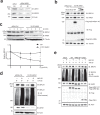Regulation of BRCA1 stability through the tandem UBX domains of isoleucyl-tRNA synthetase 1
- PMID: 36347866
- PMCID: PMC9643514
- DOI: 10.1038/s41467-022-34612-y
Regulation of BRCA1 stability through the tandem UBX domains of isoleucyl-tRNA synthetase 1
Abstract
Aminoacyl-tRNA synthetases (ARSs) have evolved to acquire various additional domains. These domains allow ARSs to communicate with other cellular proteins in order to promote non-translational functions. Vertebrate cytoplasmic isoleucyl-tRNA synthetases (IARS1s) have an uncharacterized unique domain, UNE-I. Here, we present the crystal structure of the chicken IARS1 UNE-I complexed with glutamyl-tRNA synthetase 1 (EARS1). UNE-I consists of tandem ubiquitin regulatory X (UBX) domains that interact with a distinct hairpin loop on EARS1 and protect its neighboring proteins in the multi-synthetase complex from degradation. Phosphomimetic mutation of the two serine residues in the hairpin loop releases IARS1 from the complex. IARS1 interacts with BRCA1 in the nucleus, regulates its stability by inhibiting ubiquitylation via the UBX domains, and controls DNA repair function.
© 2022. The Author(s).
Conflict of interest statement
The authors declare no competing interests.
Figures





Similar articles
-
Interaction between human tRNA synthetases involves repeated sequence elements.Proc Natl Acad Sci U S A. 1996 Sep 17;93(19):10128-33. doi: 10.1073/pnas.93.19.10128. Proc Natl Acad Sci U S A. 1996. PMID: 8816763 Free PMC article.
-
Modification of aminoacyl-tRNA synthetases with pyridoxal-5'-phosphate. Identification of the labeled amino acid residues.Biochimie. 1994;76(1):33-44. doi: 10.1016/0300-9084(94)90060-4. Biochimie. 1994. PMID: 8031903
-
A multifunctional repeated motif is present in human bifunctional tRNA synthetase.J Biol Chem. 1998 May 1;273(18):11267-73. doi: 10.1074/jbc.273.18.11267. J Biol Chem. 1998. PMID: 9556618
-
Glutamyl-tRNA sythetase.Biol Chem. 1997 Nov;378(11):1313-29. Biol Chem. 1997. PMID: 9426192 Review.
-
Aminoacyl-tRNA synthetase complexes: beyond translation.J Cell Sci. 2004 Aug 1;117(Pt 17):3725-34. doi: 10.1242/jcs.01342. J Cell Sci. 2004. PMID: 15286174 Review.
Cited by
-
The mechanism of discriminative aminoacylation by isoleucyl-tRNA synthetase based on wobble nucleotide recognition.Nat Commun. 2024 Dec 30;15(1):10817. doi: 10.1038/s41467-024-55183-0. Nat Commun. 2024. PMID: 39738040 Free PMC article.
-
AARS Online: A collaborative database on the structure, function, and evolution of the aminoacyl-tRNA synthetases.IUBMB Life. 2024 Dec;76(12):1091-1105. doi: 10.1002/iub.2911. Epub 2024 Sep 9. IUBMB Life. 2024. PMID: 39247978 Free PMC article.
-
Mechanisms and Future Research Perspectives on Mitochondrial Diseases Associated with Isoleucyl-tRNA Synthetase Gene Mutations.Genes (Basel). 2024 Jul 8;15(7):894. doi: 10.3390/genes15070894. Genes (Basel). 2024. PMID: 39062673 Free PMC article. Review.
-
Phosphocode-dependent glutamyl-prolyl-tRNA synthetase 1 signaling in immunity, metabolism, and disease.Exp Mol Med. 2023 Oct;55(10):2116-2126. doi: 10.1038/s12276-023-01094-x. Epub 2023 Oct 2. Exp Mol Med. 2023. PMID: 37779151 Free PMC article. Review.
References
Publication types
MeSH terms
Substances
LinkOut - more resources
Full Text Sources
Molecular Biology Databases
Miscellaneous

